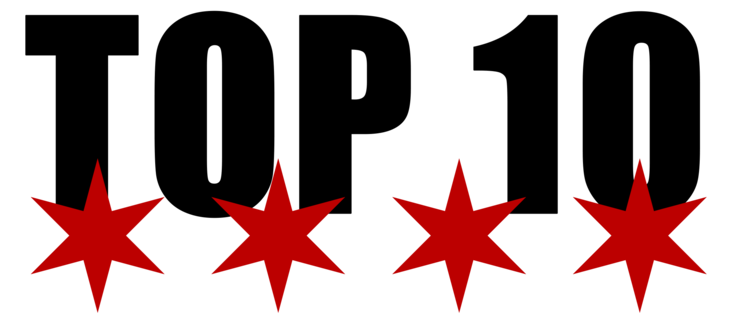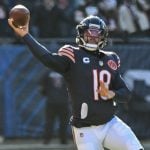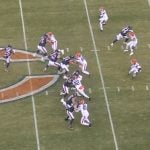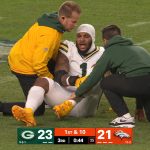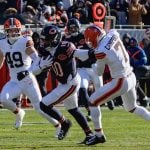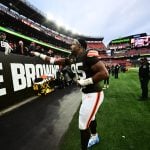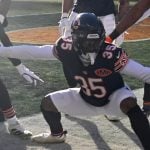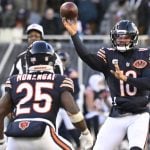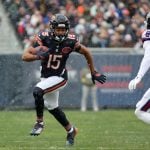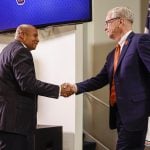Like draft picks or free agent signings, Chicago Bears trades have a mixed history with the organization. That is no surprise. Something as old as a century is bound to have its fair share of ups and downs when it comes to the exchanging of assets. Lately, they seem to be on the plus side of such maneuvers. Their most recent blockbuster netted them All-Pro pass rusher Khalil Mack. The year before that two trades secured Mitch Trubisky and Eddie Jackson.
Not bad.
However, there were times where it wasn’t great at all. When GMs gave up good assets for the fantasy of better ones only to have their rolls of the dice come up snake eyes. Maybe it was surrendering an established veteran for picks. Or maybe it was the other way around. Regardless, the end result was the same. A huge step back for the franchise.
So what does it take to qualify as some of the worst trades of the past 50+ years? It can’t be just about what they gave up and what they got in return. What separates the bad from the worst is what they could’ve gotten had they had greater common sense. Then again those men wouldn’t be on this list if that were the case.
Subscribe to the BFR Youtube channel and ride shotgun with Dave and Ficky as they break down Bears football like nobody else.
Worst Chicago Bears trades honorable mentions:
- Thomas Jones to the Jets in 2007
- Mike Ditka to the Eagles in 1967
- Eric Weddle for Dan Bazuin, Garrett Wolfe, Kevin Payne, and Marcus Harrison in 2007
- Max Unger for Jarron Gilbert and Henry Melton in 2009
7. Gaines Adams
Former GM Jerry Angelo was committed to going all in by the end of the 2000s. The Bears had just finished 9-7 in 2008, barely missing the playoffs. Knowing the star-studded core of his roster wasn’t getting any younger, he committed to equipping his roster with enough help to get back to the Super Bowl. This resulted in the infamous Jay Cutler trade.
Some may wonder why that isn’t on the list. While it’s true Cutler didn’t live up to the lofty expectations, he at least won 52 games as a Bear including a playoff game. Angelo’s far bigger misstep came later that 2009 season. Interested in adding more pass rush help for his defense, he took an unexpected gamble by shipping a 2nd rounder in 2010 to the Tampa Bay Buccaneers for former top 10 pick Gaines Adams.
The young defensive end hadn’t lived up to his potential at that point but it seems the Bears felt he could do better under Lovie Smith and Rod Marinelli. They never got the chance. Later that offseason, Adams tragically died from a cardiac arrest. This caused by a previously undiagnosed condition of an enlarged heart.
The pick the Bears gave up? That ended up in the hands of New England. They used to draft tight end Rob Gronkowski.
6. Trace Armstrong
During the 1990s, the Bears formed a bad habit of getting rid of productive veteran players in the hopes of gaining younger players who would end up as good or better. There were multiple such trades during the decade, but by far the most notable was when they shipped defensive end Trace Armstrong to the Miami Dolphins for 2nd and 3rd round picks in 1995.
The reasoning for the trade was likely a mix of money and age. Armstrong would turn 30-years old that year. He was coming off a slightly down season in 1994 with 7.5 sacks. Miami came forward with an aggressive trade offer and the Bears accepted. Unfortunately, they’d underestimated how much Armstrong still had in the tank. Not to mention they overestimated the ability of their front office to make those picks count.
With the first choice from Miami, the Bears went full unconventional by selecting West Virginia punter Todd Sauerbrun. Meanwhile, a running back named Curtis Martin slipped right past them. Then in the 3rd round, they added guard Evan Pilgrim out of BYU. He played just 32 games in the NFL. All the while an unheralded receiver named Antonio Freeman went to Green Bay three picks later.
If that weren’t bad enough, Armstrong found a new life in Miami. He’d have 56.5 sacks during his time there, more than he had in Chicago. He also made a Pro Bowl. The man played until the age of 38. As Chicago Bears trades go, this one stung.
5. Michael Haynes and Rex Grossman
Angelo was a GM who never fear making the bold move. This isn’t necessarily a bad thing. Good general managers have to be willing to take risks. The problem was when it came to trades, Angelo was not good at it. He already proved that earlier on this list but it gets worse. The 1st round of the 2003 draft offers a much better example.
The Bears held the #4 overall pick that year. It offered a tremendous opportunity to add another top talent to their already strong core of Brian Urlacher, Olin Kreutz, and Mike Brown. However, Angelo had other plans in mind. In discussions with the New York Jets, he agreed to trade #4 overall to them in exchange for the #13 and #22 picks.
Angelo was willing to sacrifice pick position in exchange for two 1st rounders. A calculated risk that could pay of big. Provided of course he found the right players with them. This traded extended a little further when he dropped down from #13 to #14 in a minor deal with the Patriots. At that point the Bears finally made their selections. They took Penn State defensive end Michael Haynes with the former and Florida quarterback Rex Grossman with the latter.
Haynes would last just three years in the NFL, collecting 5.5 sacks. Grossman was the starter on their 2006 Super Bowl team but threw 33 touchdowns with 35 interceptions as a Bear.
Had he not been so focused on certain positions, Angelo might’ve noticed a playmaking safety out of USC named Troy Polamalu at #14. Or maybe an undersized but athletic tight end out of Iowa named Dallas Clark at #22. The only reason this trade isn’t lambasted more often is the Bears secured Charles Tillman and Lance Briggs on the second day of that draft.
4. Greg Olsen
The importance of the offensive system in the NFL and finding players who fit it can’t be understated. However, there have to be limitations. A point where a team says maybe we shouldn’t sacrifice a unique athletic talent in the name of absolutely perfect scheme fits. This was a lesson the Bears learned the hard way in 2011 when Angelo made his last bad deal as GM.
Greg Olsen had been his 1st round pick for the Bears in 2007. Over the next few years, the tight end had proven himself to be a solid weapon in the passing game and a growing personal favorite of quarterback Jay Cutler. Despite having just 404 yards in 2010, he had five touchdown catches and exploded for over 100 yards in the playoff win over Seattle.
That apparently wasn’t enough to convince offensive coordinator Mike Martz that he was worth keeping around. The old coach didn’t see much value in Olsen, as his offense demanded tight ends be primarily used for blocking. So Angelo, rather than putting his foot down, acquiesced and dealt the 26-year old Olsen to the Carolina Panthers for a 3rd round pick.
Olsen has since posted 5,866 yards and 37 touchdowns since leaving Chicago. This included three-straight Pro Bowls from 2014 to 2016, helping the Panthers reach the Super Bowl in 2015. Without his presence in 2011, the Bears offense lost any sort of capability in the passing game when Cutler was lost to a broken thumb. Angelo was fired after the season ended.
3. Cade McNown
Mark Hatley was the GM in all but name during his run with the Bears from 1997 to 2000. The man made some outstanding picks along the way. Chiefs among them being Kreutz and Urlacher. However, his career was also pockmarked by some disastrous decision. None worse than the sequence that took place during the 1st round in 1999.
Chicago was in a good position that year. They held the #7 overall pick. This afforded them a strong opportunity to add another difference-maker to their roster. However, Hatley had a problem. The consensus inside the building was an upgrade at quarterback was needed. Three quarterbacks had already been selected by the time they went on the clock.
It was hardly a desperate situation.
Talented UCF QB Daunte Culpepper was still on the board. The Bears could just take him or find help at a different position and take their chances later in the draft. Hatley chose an alternate route. He worked out a deal with Washington. In exchange for #7, they received the #12 pick and four additional choices including two 3rd rounders, a 4th rounder, and a 5th rounder.
On paper, it looked like a steal for moving down just five spots. Sadly, the team didn’t take advantage. Washington selected cornerback Champ Bailey with the #7 pick. Chicago lost out on Culpepper who went to Minnesota at #11. That left them with UCLA quarterback Cade McNown. Rather than cut their losses and take the best player available, they took the 5th-best QB instead.
The results were fairly predictable. McNown started his career with a lengthy contract holdout. When he finally did play that season he was erratic and not always on top of things. Then the next year, he got worse and then suffered a shoulder injury that landed him on IR.
None of the other picks in that trade became a long-term solution for the franchise. Bailey? He went to the Hall of Fame.
2. Mike Phipps
Jim Finks remains a bit of a folk hero in Bears lore. Not surprising. This is the man who drafted Walter Payton and laid the foundation for the 1985 team that won the Super Bowl. However, the man was far from perfect. He had his own share of blunders in a long career. Most of them centering around the quarterback position.
While he’s perhaps most infamous these days for passing on Joe Montana in 1979 when the team was all prepared to take him, the bigger whiff came a year earlier in 1977. Unsure of the Bob Avellini experiment, Finks wanted to get somebody who could take some of the pressure off Payton. So he traded his 1st round pick the next year in ’78 to the Cleveland Browns for Mike Phipps.
It is unclear what in the world possessed Finks to make that move.
By that point, Phipps was a major draft bust for Cleveland. In seven seasons he’d thrown 40 touchdowns and 81 interceptions with 48.1% of his passes completed. It feels like he was more of a name than talent at that point. Phipps had been a star at Purdue. Enough to where he was drafted 3rd overall. That is the player Finks likely felt he was getting.
Phipps ended up starting 20 games for the Bears, throwing 15 touchdowns to 27 interceptions. He went 9-1 in 1979 but that was mostly due to Payton and the defense. As for that pick they gave up? It became the 23rd overall selection in 1978. Cleveland used it on a tight end out of Alabama named Ozzie Newsome.
1. Rick Mirer
Finks may have been the first Bears executive to make an ill-advised trade for a bust quarterback, but he was not the last. Nor the worst. That honor belongs to Rod Graves. Going into 1997, the Bears were once again facing uncertainty at QB. Erik Kramer had regressed badly the year before after his outstanding 1995 campaign. Veteran Dave Krieg was gone. They needed new blood at the position.
The problem was the incoming draft class was bereft of top arm talent. Only Jake Plummer would be the standout of that group. Graves was thus left with a decision. Does he take his chances on that class or see if he can find an alternative, perhaps via trade? He chose the latter. There were a few interesting options available at that point.
There was former #3 overall pick Heath Shuler who’d flamed out in Washington. Former #2 overall pick Rick Mirer. He bombed after a good rookie year and was considered a lost cause. Then there was veteran Chris Chandler who’d had two decent seasons with the Houston Oilers in which he’d thrown 33 touchdowns to 21 interceptions.
Graves chose to go with Mirer.
Not only that, but he gave up the Bears’ 1st round pick in the draft to get him. The 11th overall pick, no less. Even members of the Seahawks front office couldn’t believe the Bears had agreed to that deal. It was plain as day that Mirer would never be a prominent starter in the NFL. Giving up a pick that high for a fleeting bit of hope was madness.
Mirer started three games for the Bears and didn’t throw a single touchdown pass. Seattle ended up trading that pick as part of a package to go up and get Pro Bowl corner Shawn Springs. The pick itself became defensive back Michael Booker. The two picks directly after that? A swift running back named Warrick Dunn out of Florida State and a tall, athletic tight end out of Cal named Tony Gonzalez.
As Chicago Bears trades go, this was rock bottom.



